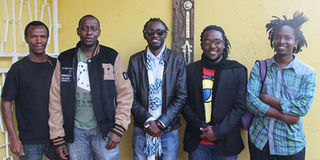Why Brush Tu artists have a good reason to celebrate

The first five: David Thuku, Michael Musyoka, Boniface Maina, Waweru Gichuhi and Elias Mung'ora . PHOTO | MARGARETTA WA GACHERU
What you need to know:
- Thuku found it was just too much for one artist. So since he had recently met Maina at a mutual friend’s house and discovered they had a lot in common, he called Maina to help him out.
- He also called his former classmate from Buru Buru Institute of Fine Art (BIFA), Musyoka for help.
- That is how they came to work together.
Brush Tu artists celebrated the fifth anniversary of their studio’s ‘birth’ last weekend. Coincidentally, it was the same day as one of its three founder members, Michael Musyoka, was also celebrating a birthday.
But frankly, Brush Tu artists are likely to be celebrating many more times this year once fellow artists and friends find out this year’s ‘historic’ for the trio of trailblazing artists as well as for the other six who have joined the group since it began in 2013.
“The (Brush Tu) celebration was really impromptu since we had just intended to celebrate Michael’s birthday,” says Boniface Maina, one of the troika.
“But when we realised we had also moved into our first studio space (on Outer Ring Road) in May, we decided the celebration should be for us all,” adds Maina who had recently come to YMCA Technical Institute back then.
The ‘we’ he refers to are the three founding artists, all of whom were painters at the time (which is where the studio’s title came from). They are David Thuku, Michael Musyoka and Boniface Maina.
And the one who actually got the trio going was Thuku, since it was he who had started painting backdrops for schools taking part in the Kenya Schools Drama Festival. His work had started with one school, but then other schools’ directors wanted similar set designs.
Thuku found it was just too much for one artist. So since he had recently met Maina at a mutual friend’s house and discovered they had a lot in common, he called Maina to help him out. He also called his former classmate from Buru Buru Institute of Fine Art (BIFA), Musyoka for help. That is how they came to work together. And as they got along well, they decided to look for studio space that they could share. It took a while but Michael finally found it on the edge of Buru Buru Phase 1.
“One reason we wanted a space was so we could invite clients to come see our work,” says Maina. “We encouraged them to stop by on Sundays since there was less traffic and we said we had ‘free parking’.”
Their warm welcoming attitude as well as the increasing interest in their art inspired a number of young artists to come around to see their work. That included the next two future members of Brush Tu, namely Wachira Gichuhi and Elias Mong’ora. They joined the collective in 2014, now making five.
“Wachira and Elias came around just as we were thinking of finding a bigger space,” recalls Maina. All five pitched in on rent, first at the Outer Ring space. And then when the quintet found an actual house recently vacated just down the road, they booked it and moved in as quickly as they could.
Their new space needed quite a bit of renovation, but everyone found rooms of their own, although Thuku was already feeling he might need an even bigger space in which to work. He has remained a founder member of the group; but eventually he shifted, first to Kuona and now he is based at Kobo Trust.
Meanwhile, in 2015, the sculptor and former principal at BIFA, Kimani Ngaru, came looking for space to sculpt. Wanting to come back from being an administrator to being a practising artist, Kimani was readily welcomed into the fold of busy painters.
But 2016 was the year even more changes arose at Brush Tu. Abdul Kipruto, fresh from Egerton University, was welcomed in, initially as an intern, then as a full-fledged member.
It was also the time when Lincoln Mwangi and Peteros Ndungu showed up from Kenyatta University and stayed.
But 2016 is also when the group decided they wanted to open their doors even farther to young aspiring artists. They began designing a whole ‘artist-in-residence’ program, but their one obstacle was the means to fund it. That’s when the Danish Embassy came in.
It is also when a young art-loving accountant, Emmaus Kimani, arrived on the scene ‘in the nick of time’. The Danish embassy was prepared to fund the project but only after there was a budget attached. Emmaus was the man to do that.
The rest is history because 2017 brought both young Kenyan, East and West Africans to work at Brush Tu, assisted by the Danes for that one year. It was a time of immense learning and exciting artistic output. It also proved that after five good years, Brush Tu has solid grounds on which to celebrate.




